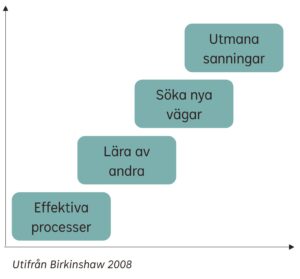Why is it so difficult to develop public governance?
In 1903, the first edition of the Tour de France was run. The similarities between the victors of 1903 and 2023 are that they are people who have traveled a long distance. There the similarities end. The two bikes are to be considered completely different means of transport and the winner spends all his waking hours training, eating right and planning for a successful competition.
If we compare with management and control in public activities, today we have tools, strategies and visions to create managers and employees who are on a par with today's professional cyclists. The steering on the other hand is more or less the same as the Steel Horse from 1903.
The expectations and demands on leadership have developed enormously over the past 40 years, and my experience from many municipalities and regions is that both skills development and support for management groups and managers are well taken care of - we know and act to create good conditions for sustainable and modern leadership . For the individual manager, there are often conditions for becoming a professional cyclist!
It is therefore sad that the cyclist sits on a bike that has not developed significantly since 1903. Governance in the public sector is tightly linked to follow-up, deviations, budget management and plans that limit the business's opportunities for innovation, collaboration and development.
To create the racing bike of the future for public activities, we need increased investment in innovation of the control systems. It is a challenge within complex situations and it cannot be handled by individual parts of the organization that today own the issue – it needs to involve everyone.
To begin the development of governance in public activities, we should start by considering three perspectives:
1. Are we prepared to change the exercise of power?
The most common argument raised by, among other things Julian Birkinshaw is that a change in management leads to a change in the exercise of power - and that is true. We have now exercised power under the same structures for over 100 years. The question you need to ask yourself is whether the exercise of power is effective, as the outcome is roughly the same every time.
Identifying the politics and top management's actual incentives for and against a change is crucial for the process to reach its goal - because it will be shaky along the way - it will be in change processes. Then consensus and motivation are put to the test.
2. Are we prepared to adapt the management to the conditions of the business?
It becomes complex if a business with everything from preschools to growth offices is to be managed in the same way. One of the problems with a hierarchical command structure is that everyone must jump at the same time - then it becomes bureaucratic and complicated. Therefore, build from below, based on the conditions of the different administrations and operations - but agree on what is required for a joint movement in the direction the municipality wants to take.
3. How far are we prepared to challenge existing structures?

An innovation of governance requires us to challenge old truths, decisions and perhaps the actual meaning of legal texts. Depending on incentives and resistance, one should identify how far one dares to go on the innovation scale. Streamlining one's processes or doing like predecessors will probably have an effect, but rarely creates effects that are greater than what the predecessors have already achieved.
Creating real innovation requires courage. Courage to partially let go of control and make decisions that may partially challenge conventional norms.
If man had not dared, we would still be cycling the Tour de France homespun.